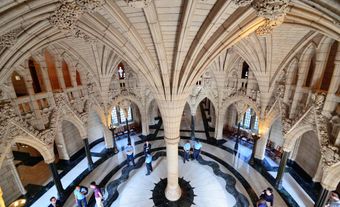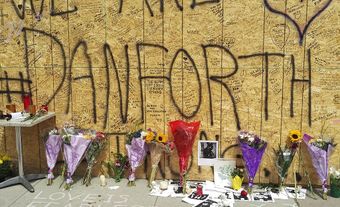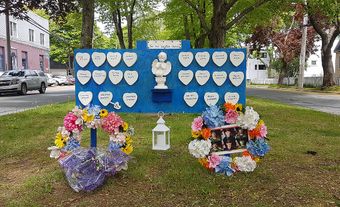At 9:45 a.m. on Tuesday, 8 May 1984, a 25-year-old army corporal entered the National Assembly in Quebec City and opened fire, shooting 16 people and killing three. The shooter had expressed his desire to “destroy” the Parti Quebecois government then in power. The shooter sat in the Speaker’s chair in the legislature, periodically firing a submachine gun. The Assembly’s Sergeant-at-Arms, Rene Jalbert, entered the room and struck up a rapport with him. Over the next four hours, he convinced the shooter to give himself up to military police. Jalbert was hailed as a hero. The shooter served 10 years in prison for second-degree murder. It remains one of the deadliest acts of political violence and terrorism in Canadian history.
The Shooter
The shooter, Denis Lortie, was born in Quebec City on 10 March 1959, the youngest of eight children. He has testified that he and his siblings were physically and sexually abused by their father. The father was convicted of incest and left the family home when the shooter was 10 years old. The shooter joined the Canadian Armed Forces at age 17. At one point, he was assigned to a naval destroyer and was stationed in Halifax.
The shooter married in 1980, had a son in 1982 and a daughter in 1983. In 1984, he was serving as a supply technician at CFS Carp, an underground bunker designed to serve as an emergency command centre for the Canadian government during the Cold War. The shooter was armed with two submachine guns, two handguns and a bag of ammunition, all of which he had taken from CFS Carp.
The Attack
About 20 minutes before the rampage began, the shooter brought a 45-minute, tape-recorded message to the studios of Quebec City radio station CJRP. He told staff to give the tape to host Andre Arthur and to play the recording at 10:00 a.m. One staff member was uneasy with the request, particularly because the shooter was dressed in army fatigues and had a large hunting knife on his belt. Andre Arthur and his staff listened to the recording; the shooter threatened to destroy the Parti Quebecois “for doing much wrong to the French-language people of Quebec and the rest of Canada.” He also said, “I will kill everyone, everyone in my path.” After hearing that, Arthur immediately contacted police. By this time, however, the rampage had already begun.
The shooter began his rampage at the Citadel, located on the Plains of Abraham. The shooter unleashed a long burst of submachine gunfire, though he didn’t hit anyone. He then drove about 200 m to a side entrance of the National Assembly, where he again opened fire. It was roughly around this time that radio host Arthur was alerting the police. According to witnesses, the shooter said “Where are the MNAs? I want to kill them!” (MNA stands for Member of the National Assembly.)
The shooter fired hundreds of rounds of ammunition from his two submachine guns. He made his way through the building, firing indiscriminately. Hearing the gunshots from another part of the building, a group of about 50 elementary school students took cover under tables and chairs. At one point, the shooter shot through the entrance doors to the Assembly’s restaurant. He then made his way to the Assembly’s Salon Bleu, the legislative chamber, where technicians and other staff were preparing for a meeting. (Luckily, the legislature was not scheduled to be in session until later that afternoon.) The perpetrator shot and killed two people in the corridor between the front lobby and the Salon Bleu, and a third person in the Salon Bleu itself. In only a few minutes, he had shot 16 people. Twelve Assembly employees, a tourist, and a construction worker doing renovations were injured. Three people were killed: government employees George Boyer (age 59) and Camille Lepage (age 54), and electoral office employee Roger Lefrancois (age 57).
Negotiations with Rene Jalbert
The shooter was sitting in the Speaker’s chair at the front of the Salon Bleu when Rene Jalbert entered through a door several metres away. Jalbert was the Assembly’s Sergeant-at-Arms (head of security). He had been a soldier in the legendary Van Doos regiment and was a veteran of both the Second World War and the Korean War. The victims of the shooter’s rampage were still in the room, as were many others who had taken cover. The shooter continued firing his weapon at random intervals, at one point shooting out a clock face.
Jalbert, standing in the doorway, began calmly talking to the shooter. He quickly established a rapport based on their service in the army. Jalbert convinced the shooter to let people leave the building and to go with him to Jalbert’s downstairs office to “have a coffee and discuss things.” The shooter agreed. When the two men got to Jalbert’s office, his secretary was there. Jalbert introduced her to the shooter, who kissed her on the cheek before Jalbert told her to leave. Once they were alone, Jalbert insisted that the shooter address him as major, while he addressed the shooter as corporal. Doing so changed the power dynamic between the two men, and the shooter responded well to Jalbert’s authority. At one point, the conversation was interrupted by a phone call from Jalbert’s wife, who wanted to ensure he was okay. The shooter demanded to know who was calling; when Jalbert told him, he said, “Say hello to her from me.”
As the two men continued their discussion, police cleared the building and evacuated the wounded. Jalbert arranged for military police from the nearby Valcartier military base to escort the shooter to a waiting police car. He was taken into custody, ending the siege just before 2:30 p.m. Rene Jalbert went home to his wife and had “several scotches.” He returned to the Assembly the next day and was greeted with a standing ovation for his heroic actions.
Trial and Sentencing
Though the shooter had initially claimed he wanted to destroy the Parti Quebecois government, he later changed his story. At trial in 1987, he said that he had been driven into a state of mental instability by abuse he had suffered at the hands of his father, and that the PQ government reminded him of his father.
In May 1985, the shooter received a life sentence. However, it was struck down by the Court of Appeal of Quebec in autumn 1986; it ruled that the original presiding judge had wrongly instructed the jury to reject the expert testimony of three psychiatrists who were of the opinion that the shooter was insane at the time of the rampage. The shooter subsequently pleaded guilty to three counts of second-degree murder in 1987. He was paroled in 1996.
Legacy
The shooting led to increased security measures at the National Assembly, including the presence of armed police officers and metal detectors. Rene Jalbert was credited by most of the Assembly’s staff with saving their lives. He was awarded the Cross of Valour by the Canadian government for his bravery. He died of cancer in 1996 at the age of 74.
On 18 September 2014, a memorial plaque commemorating the victims of the shooting was unveiled at the National Assembly. The plaque reads: “In addition to deeply affecting the lives of a number of witnesses, it [the shooting] shook all of Quebec society. Quebec and the National Assembly will never forget those who lost their lives in the service of democracy.

 Share on Facebook
Share on Facebook Share on X
Share on X Share by Email
Share by Email Share on Google Classroom
Share on Google Classroom



